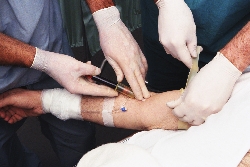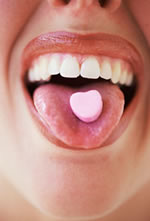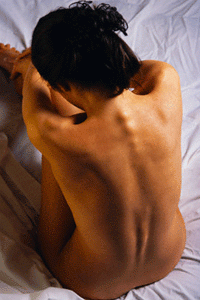Subcutaneous injections and infusions
 Due to the fact that the subcutaneous fat layer is richly supplied with blood vessels, for a more rapid action of the drug substance, subcutaneous injections are used.
Due to the fact that the subcutaneous fat layer is richly supplied with blood vessels, for a more rapid action of the drug substance, subcutaneous injections are used.
Usually they inject solutions of drugs that are quickly absorbed by loose subcutaneous tissue and do not have a harmful effect on it. Subcutaneous, you can enter the liquid from a small amount to 2 liters.
When conducting subcutaneous injections should avoid the neighborhood of large vessels and nerve trunks. The most convenient areas for injection are the outer surface of the shoulder or the radial edge of the forearm, subscapularis, the anterior outer surface of the thigh, the lateral surface of the abdominal wall and the lower part of the axillary region.
In these areas, the skin is easily caught in the fold and there is no danger of damage to the blood vessels, nerves and subcutaneous fat.
Injections and bases are not recommended together with edematous subcutaneous fatty tissue or in compaction after previous injections.
With subcutaneous administration, absorption of medicinal substances, and consequently, in the manifestation of the therapeutic effect, occurs more slowly than with intramuscular and intravenous administration. However, they act in this case for a longer time. In case of insufficiency of the peripheral circulation, the subcutaneously injected substances are poorly absorbed.
Immediately prior to injection from the syringe, holding it vertically with the needle upward, force out the air. If the air bubbles in the solution are small, you need to delay the piston so that they merge into one big one, and then with the movement of the piston get rid of it.
The surface of the skin, where they are going to do the injection, is wiped twice with sterile wadded balls, soaked in alcohol. The first time they wash the A section of 10×10 cm, the second cotton ball – the puncture site itself is 5×5 cm. Then this place is smeared with an alcohol solution of iodine. If the skin is very polluted, it must be pre-treated with ether.
For injections of aqueous solutions, a thin needle is taken, for injections of oils – a needle is thicker, for subcutaneous injections – a needle 90 mm long with a lumen of 1 mm. With the left hand, the skin at the injection site is seized in the fold, into the base of which a needle is inserted with a quick movement. There are two ways to hold a syringe and puncture the skin.
In the first method, the cylinder of the syringe is clamped between the first and second or third fingers, the fourth and fifth fingers and hold the piston. An injection is made into the base of the skin fold from the bottom up (the patient stands) at an angle of 30 ° to the surface of the shoulder. When the skin is punctured, the lumen of the needle should always be facing up.
For subcutaneous, intramuscular, and intravenous injections, the needle is not injected fully, but approximately 2/3 of the length, since its fracture can occur only at the junction with the sleeve. Having punctured the skin, the syringe is shifted to the left hand, the second and third fingers of the right hand are clamped to the rim of the cylinder, and the first finger is pressed on the piston grip, injecting medicine. Then apply fresh cotton ball soaked in alcohol to the place of vcol with the left hand and quickly remove the needle. The injection site is lightly massaged with a cotton ball so that it is better distributed in the fiber and does not come back.
Place a puncture of the skin smeared with an alcoholic solution of iodine. To avoid burns, a cotton ball dipped in an alcoholic solution of iodine cannot be kept at the injection site for a long time.
In the second method, the filled syringe is held vertically with the first and third or fourth fingers, with the needle down. Quickly inserting the needle, press the piston grip with the second finger and inject the medicine, after which the needle is removed.
Complications
violation of the rules of asepsis and insufficient sterilization of the solution can lead to local inflammation until the development of a septic process. Clinically manifested by hyperthermia at the injection site, swelling. Hyperthermia may be of a general nature;
erroneous introduction of 10% sodium chloride solution (hypertonic solution) instead of 0.85% saline solution or some other hypertonic solution can lead to local necrosis;
the introduction of too hot solution (above 40 ° C) may also cause tissue necrosis;
erroneous administration of drugs not prescribed by a doctor or contraindicated for this patient may be fatal.
The most common (more common) complication is infiltration – this is “reactive multiplication of tissue cells” around the site of mechanical injury (as a result of injection with a blunt needle) and chemical irritation with a drug substance. especially oil solutions and suspensions; as a result of ingestion of a microbial agent.
Infiltration – local compaction and tissue enlargement. The mechanism of development of infiltration in each case will be different, although the initial and final stages may coincide.
With the introduction of poorly soluble drugs slows their absorption. To speed up the resorption of the resulting infiltrates, apply warming compresses, physiotherapy.





